Antalya’s Turkish Riviera provides a gateway to a captivating historical journey. Travelers can uncover the well-preserved ruins of Perge, Aspendos, and Side – ancient Hellenistic and Roman settlements that offer a glimpse into the region’s storied past. From the iconic Roman theater of Aspendos to the golden-hued ruins of Side’s temples, this private tour promises to transport visitors back in time. As the day’s exploration draws to a close, the mesmerizing sunset casts a warm glow over the ancient sites, leaving one eager to discover more about these remarkable archaeological treasures.
Key Points
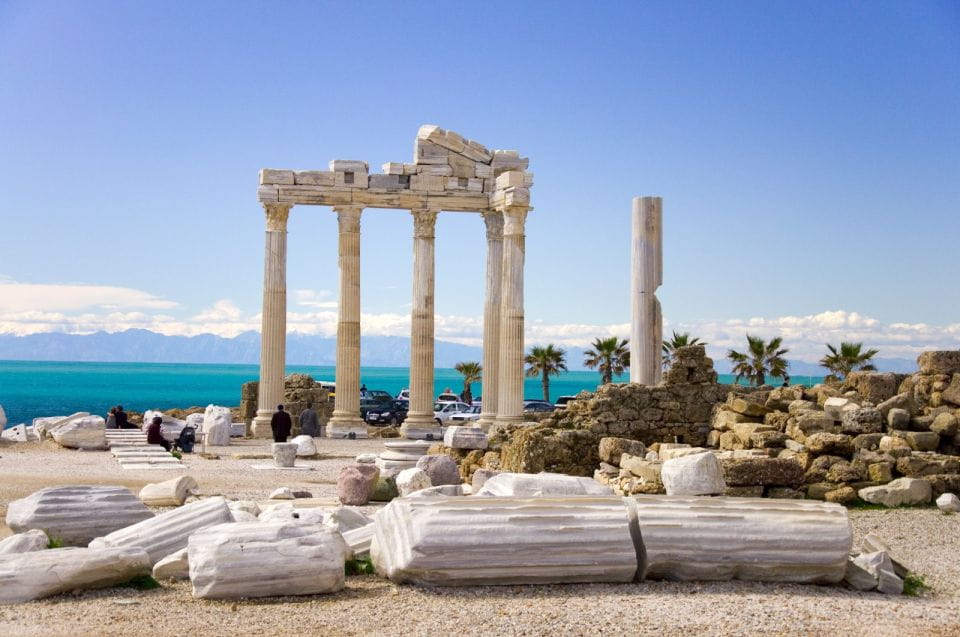
- A private tour from Antalya exploring the historical cities of Perge, Aspendos, and Side along the Turkish Riviera.
- Visit the well-preserved ruins of the ancient Greek city of Perge, including its stadium, baths, and columned street.
- Marvel at the impressive Roman theater of Aspendos, one of the best-preserved in the region, and its towering aqueducts.
- Discover the ancient port city of Side, featuring the Agora theater, Temple of Apollo, and Temple of Athena.
- Experience the archaeological wonders of these Hellenistic and Roman settlements, offering a glimpse into the rich history of the region.
Antalya’s Historical Excursion
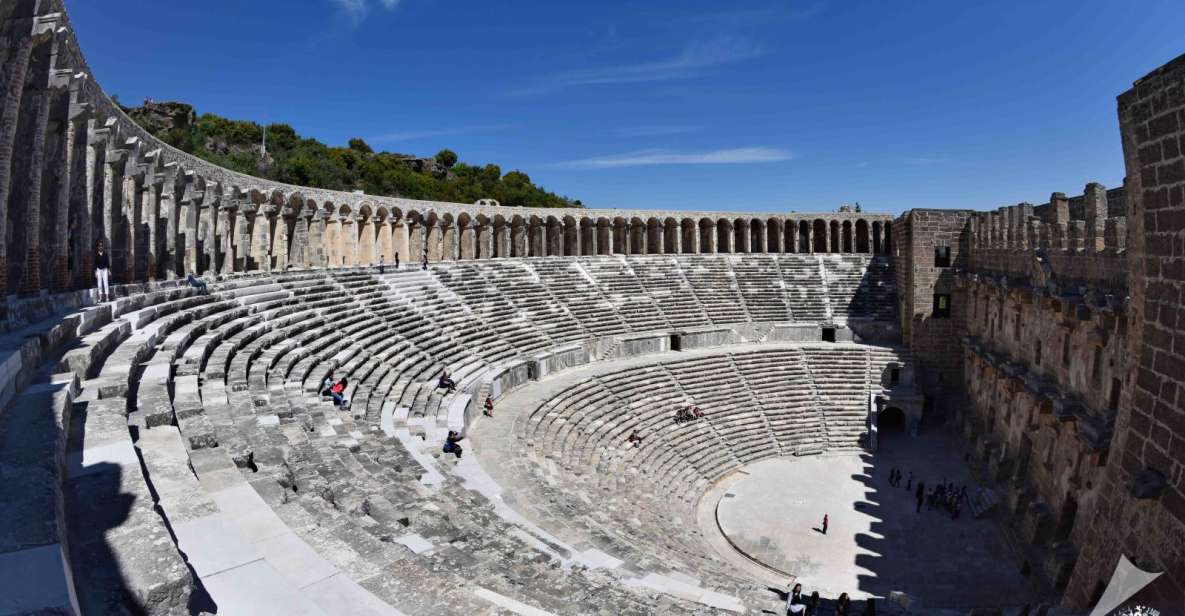
Nestled along the Turkish Riviera, Antalya offers visitors a chance to enjoy the region’s rich historical legacy through a private tour that explores the ancient cities of Perge, Aspendos, and Side.
This full-day excursion takes travelers back in time to uncover the well-preserved ruins of these Hellenistic and Roman settlements.
Perge, once a prosperous Greek city, boasts a stadium, baths, and a columned street, offering a glimpse into the daily lives of its ancient inhabitants.
The highlight of the tour is the remarkably intact Roman theater at Aspendos, which could hold up to 7,500 people.
The final stop, Side, reveals the grandeur of the Temple of Athena and the stunning seaside setting.
Want to dig deeper into Antalya? We've also reviewed these city tours
Exploring Perge Ancient City
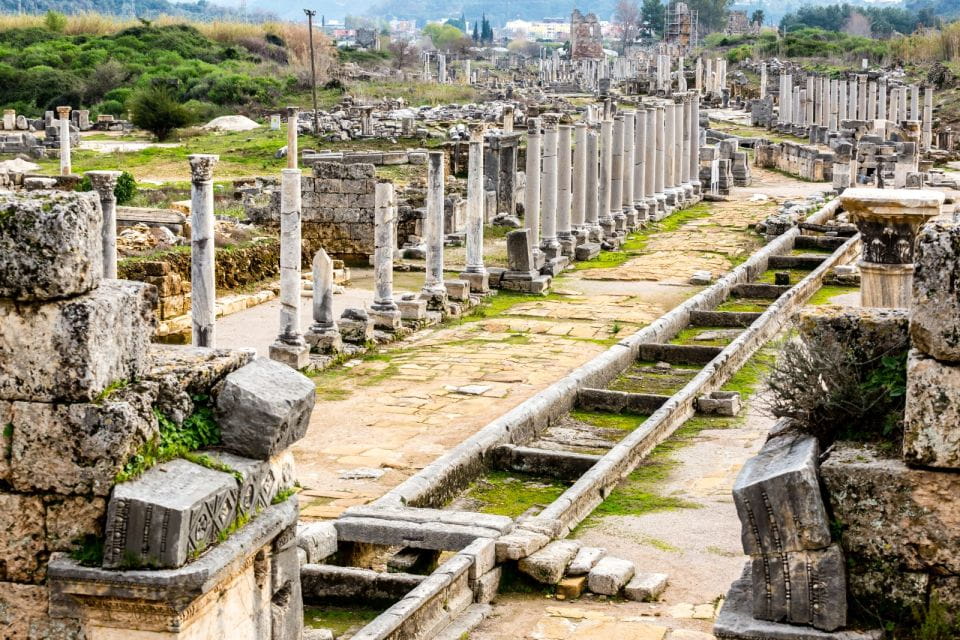
As part of the private tour, visitors explore the ancient Greek city of Perge, marveling at its well-preserved ruins that provide a window into the lives of its past inhabitants.
They’ll walk through the impressive Roman gate and discover the ancient stadium, once home to thrilling athletic events.
The tour then leads them to the Nymphaeum, an elaborate fountain, and the sprawling Roman baths, where locals once gathered.
Moving on, they’ll stroll along the columned street, imagining the bustling market that once filled the state agora.
Throughout the exploration, visitors are struck by the grandeur and scale of this Hellenistic city, which offers a fascinating glimpse into the region’s rich history.
Architectural Wonders of Aspendos
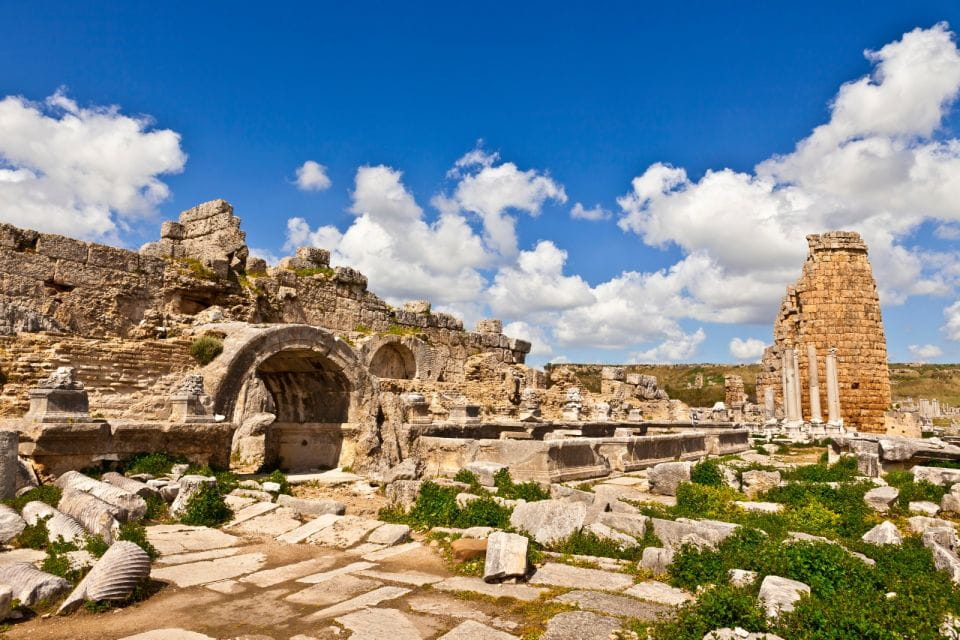
Upon arriving at Aspendos, visitors are immediately struck by the sheer scale and architectural grandeur of the region’s most well-preserved Roman theater.
Constructed in the 2nd century AD, the Aspendos Theater could hold around 7,500 people and measures an impressive 100 meters wide. Visitors are awed by the theater’s exceptional acoustics, which have been remarkably well-preserved over the centuries.
Equally impressive are the nearby Roman aqueducts, which stand up to 30 meters high and once transported water from the nearby mountains to the ancient city. These engineering marvels showcase the advanced construction techniques and capabilities of the Roman Empire, leaving modern-day visitors in wonder of their enduring legacy.
Impressive Aspendos Aqueducts
Towering up to 30 meters high, the imposing Roman aqueducts of Aspendos stand as testament to the engineering prowess of the ancient civilization.
Constructed to transport water from the nearby mountains, these majestic structures showcase the remarkable capabilities of Roman builders, leaving modern visitors in awe of their enduring legacy.
The key features of the Aspendos aqueducts include:
- Impressive height: Reaching an impressive height of 30 meters, the aqueducts are one of the tallest Roman constructions in the region.
- Intricate design: The aqueducts feature a sophisticated design, with arched spans and carefully engineered channels to efficiently channel water over long distances.
- Enduring construction: Despite their age, the aqueducts have withstood the test of time, standing as a testament to the durability of Roman engineering.
Discovering Side Ancient City
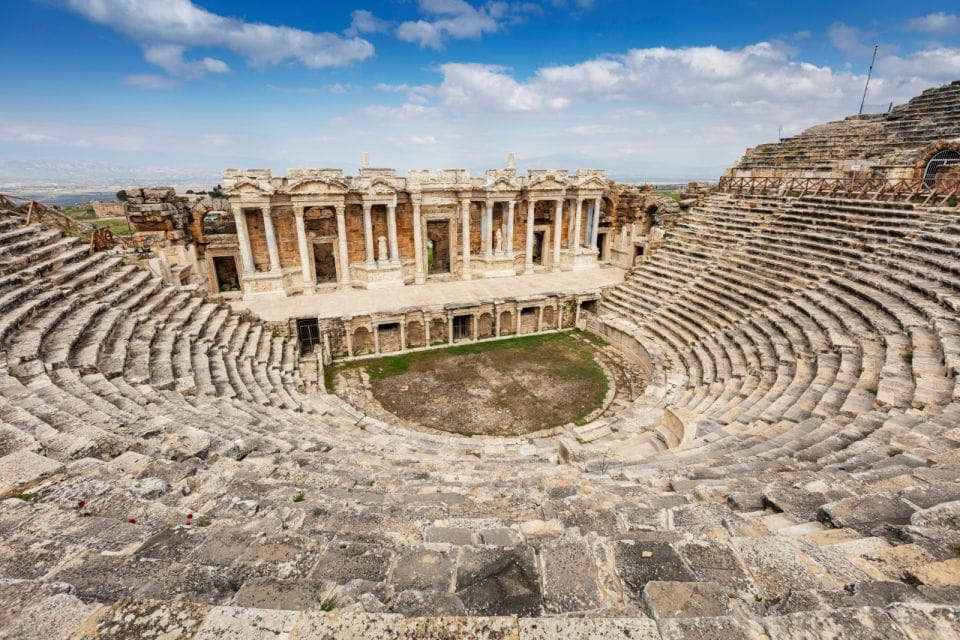
Nestled along the Mediterranean coast, the ancient city of Side beckons visitors to explore its rich history and captivating ruins.
Founded in the 7th century BC, Side was once a thriving port city and an important center of commerce, serving as a strategic trading hub during the Hellenistic and Roman eras.
Visitors can witness the grandeur of the city’s past by wandering through its well-preserved archaeological site. The highlights include the impressive Agora theater, the towering Temple of Apollo, and the stunning white marble columns of the Hellenistic Temple of Athena near the harbor.
As the sun dips below the horizon, the ancient ruins are bathed in a warm, golden glow, offering a mesmerizing end to the day’s exploration.
Want to keep it personal? More private experiences we love in Antalya
The Agora Theater in Side
The Agora theater in Side stands as a testament to the city’s ancient grandeur, its impressive size and well-preserved state captivating visitors to this day. Constructed in the 2nd century AD, this grand amphitheater could seat up to 20,000 people and was a hub for cultural events and public gatherings in the past.
Some key features of the Agora theater include:
- Its massive seating capacity, allowing it to host large-scale performances and assemblies.
- Intricate architectural details, such as the ornate stage and the remarkable acoustics that carried sound remarkably well.
- Its strategic location near the city’s harbor, making it a central part of Side’s social and civic life.
Exploring the Agora theater provides a glimpse into the vibrant history and cultural significance of the ancient city of Side.
Hellenistic Temple of Athena
Situated near the harbor, the Hellenistic Temple of Athena stands as a magnificent relic of Side’s ancient past.
Its white marble columns and intricate architectural details evoke the grandeur of the city’s Hellenistic era, when it flourished as a prominent center of trade and culture along the Mediterranean coast.
Constructed in the 3rd century BC, the temple was dedicated to the goddess Athena, the patron deity of the city.
Though much of the original structure has been lost over the centuries, the surviving remains still captivate visitors with their timeless beauty and the sense of history they embody.
The temple’s strategic location overlooking the harbor underscores its importance as a focal point of Side’s cultural and religious life in antiquity.
Sunset in Side Ancient City
As the sun dips below the horizon, the ancient city of Side comes alive with a captivating display of light and shadow. Visitors are treated to a breathtaking sight as the golden rays cast a warm glow over the city’s well-preserved ruins, casting an enchanting ambiance across the once-bustling harbor.
The sunset in Side offers a truly remarkable experience:
Witnessing the ancient Temple of Athena‘s white marble columns glisten in the fading light.
Observing the Agora theater come into focus as the shadows deepen, evoking a sense of the city’s rich history.
Capturing the serene silhouettes of the aqueducts against the vibrant sky, a testament to the engineering prowess of the Roman era.
The sunset in Side is a captivating finale to a day spent exploring this ancient and enchanting coastal city.
Frequently Asked Questions
Are Food and Drinks Provided During the Tour?
No, the tour does not include food or drinks. Visitors are responsible for bringing their own meals and refreshments during the full-day excursion to the ancient Hellenistic Roman cities and theaters.
Is There a Break for Lunch During the Tour?
There is a break for lunch during the tour. Visitors have the opportunity to enjoy a local meal at a restaurant in the area, allowing them to recharge before continuing the exploration of the ancient sites.
Can the Tour Be Customized to Suit Individual Preferences?
Yes, the tour can typically be customized to suit individual preferences. Travelers can discuss their interests with the tour operator and potentially adjust the itinerary or duration to meet their specific needs and desires.
What Is the Cancellation and Refund Policy for the Tour?
The cancellation and refund policy typically allows for full refunds if canceled at least 24 hours in advance. Last-minute cancellations may incur fees. Customers should review the policy details before booking to understand the terms and conditions.
Are There Any Additional Costs or Fees to Be Paid on the Day of the Tour?
The tour includes all admission fees and transportation. There are no additional costs or fees to be paid on the day of the tour. Visitors should only bring spending money for any personal purchases or meals they may want.
Recap
Exploring Antalya’s rich history, visitors uncover ancient Hellenistic and Roman settlements.
The well-preserved ruins of Perge, Aspendos, and Side offer a captivating glimpse into the past.
The iconic Roman theater in Aspendos, towering aqueducts, and the golden-hued ruins of Side’s Agora, Temple of Apollo, and Temple of Athena provide a mesmerizing end to the day’s exploration.
More City Tours in Antalya
- From Antalya:Near City Center Desert Buggy Safari
- Full-Day Antalya Old City Tour: Kaleiçi, Waterfalls & Boat
- Antalya Waterfalls and Old City Tour
- Antalya City Tour: 2 Waterfalls old city & Boat Ride
- Antalya: Demre, Myra & Kekova Sunken City Boat Trip w/ Lunch
- Antalya: Perge, Aspendos & City of Side Day Trip with Lunch
More Tours in Antalya
- SideAlanya: Jeep Safari, Tazi Canyon, and Selge Theater Tour
- Antalya: Full-Day Pamukkale and Hierapolis Tour & Lunch
- Antalya: Exclusive Mini Group Fishing Tour – Catch & Grill
- From Antalya, Belek, Kundu: Lara Harbor Pirate Boat Tour
- From Kemer, Antalya, Belek: Adrasan Suluada Island Boat Tour
- Belek: ATV Safari Tour
More Tour Reviews in Antalya
- Kemer Pirate Boat Tour from Antalya/Belek / Kemer
- From Alanya, Side, Antalya: The Land of Legends Night Show
- From Antalya/Kemer: All-Inclusive Party Boat with Lunch
- From Antalya: Roman Ancient Sites & Manavgat Waterfall Tour
- Suluada Boat Tour from Side, Antalya & Kemer: Swim & Lunch
- Antalya:Canyoning,Rafting,Zipline,Canyon visit with Lunch
Not for you? Here's more things to do in Antalya we have recnetly reviewed
- From Antalya: River Rafting in the Köprülü Canyon
- Full Day Alanya Experience from Side & Alanya
- Traditional Turkish Bath & Spa Experience in Antalya
- Antalya: Green Canyon Boat Trip w/Lunch near Green Lake
- Day Tour of Ancient Roman Sites with Lunch and Guide
- Private Quad & Buggy Desert Safari Tour
- Best of Antalya: Private Walking Tour with Local
- From Antalya/Kemer: Suluada Boat Trip w/Lunch & Snorkeling
- Maldives: Suluada Boat Tour with Lunch, Transfer & Bays
- Side&Alanya:Rafting,Jeep,Quad/Buggy Safari/Zipline wLunch
- Koprulu Canyon Rafting and Canyoning incl. Lunch w/Transfer
- Antalya Old Town: Traditional Mosaic Lamp or Candle Workshop
